What to See in Mérida - Quick Tourism Guide
Mérida preserves one of the most complete archaeological ensembles on the Iberian Peninsula. In addition to the impressive Roman legacy (Augusta Emerita was an important city during the Roman Empire), you can observe the city's historical evolution throughout the Visigothic, Arab, and Christian periods.
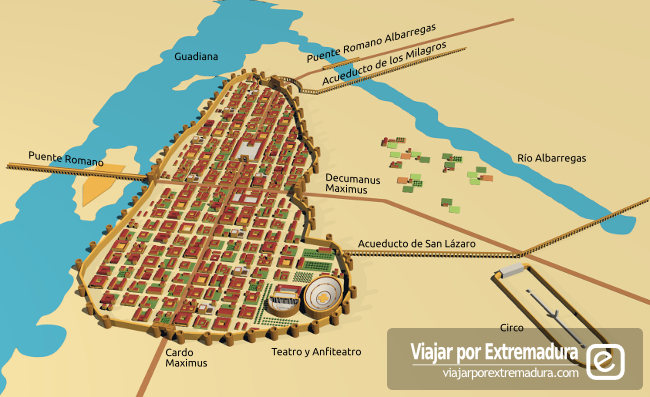
Plan Your Visit to Mérida
When is the best time to visit Mérida?
Any time of the year.
Keep in mind that during the hottest summer months, it can get quite hot, and it’s recommended to visit the monuments early in the morning.
How much time do we need to visit Mérida?
Ideally, a visit of several days or even a week to explore all the monuments and points of interest comfortably.
The most important monuments can be visited in a couple of days.
We will propose an itinerary organized over several days, which you can adapt based on your interests and circumstances.
- Day 1 | Theater and Amphitheater Area, including the MNAR (National Museum of Roman Art) and the House near the Amphitheater
- Day 2 | House of Mitreo and Columbariums, monuments in the center of Mérida, Arab Alcazaba, archaeological area of Morerías, and Roman Bridge over the Guadiana River
- Day 3 | Roman Circus, San Lázaro Aqueduct, Baths, Miracles Aqueduct, Roman Bridge over the Albarregas River
- Day 4 | Museum of Visigothic Art and Culture and Basilica of Santa Eulalia
Tickets for Monumental Sites
To visit some of the monuments, it is necessary to purchase tickets.
The most practical option is to buy the global ticket, which allows access to many ancient sites at a reduced price.
Roman Theater and Roman Amphitheater
The Roman Theater of Mérida is one of the most spectacular and well-preserved buildings from the Roman era in Mérida. It was built around 16-15 B.C.
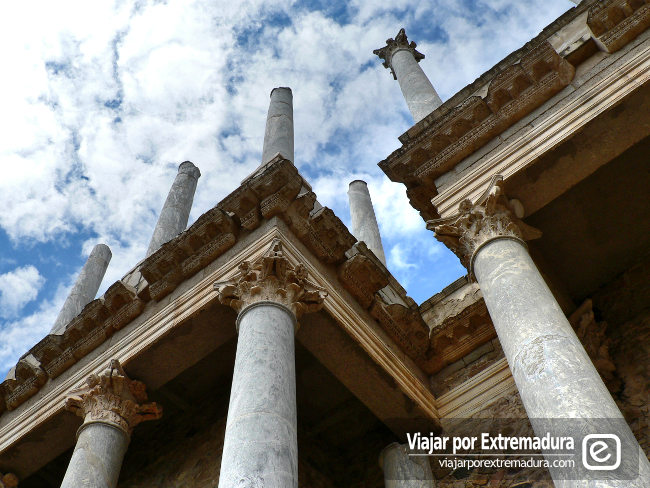
It had a capacity for about 6,000 spectators, and it was used for theatrical performances (mainly tragedy and comedy).
The Roman Theater is still used today for performances (e.g., the Mérida Classical Theater Festival), institutional events, and concerts.
At the back of the stage was the Peristyle, a garden area adorned with statues.
The Roman Amphitheater of Mérida is located next to the Roman Theater and is part of the same monumental complex (they are visited together).
It was built around 8 B.C., and it hosted gladiator fights and theatricalized recreations of historical battles.
MNAR - National Museum of Roman Art
The National Museum of Roman Art offers one of the best collections of Roman-era sculpture and mosaics in Spain.
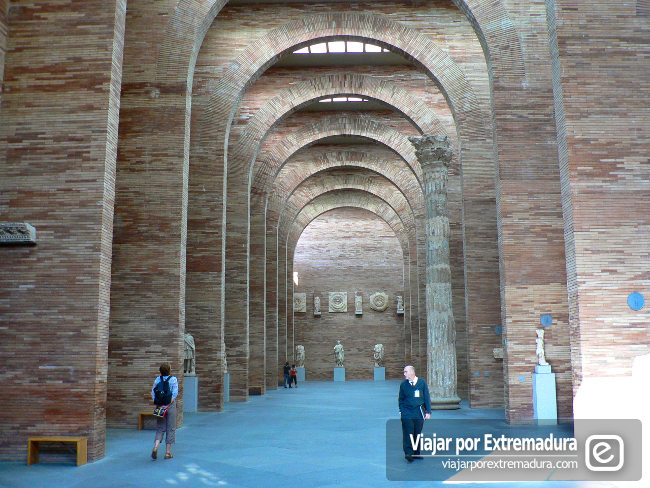
National Museum of Roman Art in Mérida
The building was designed by Rafael Moneo, and its forms are based on the semicircular arches used by Roman architects.
The museum is located a few meters from the Roman Theater.
House of the Amphitheater
This building (located outside, near the city walls) was the residence of a very relevant family in Augusta Emerita.
One of the main attractions is the impressive mosaics that can be seen inside many of the rooms and corridors.
Additionally, next to the house, you can see the remains of private baths and part of the San Lázaro Aqueduct.
The route is adapted for people with reduced mobility.
Monuments in the center of Mérida
On this second day, we will tour different monuments in the city.
The House of Mitreo is a bit more separated from the center, towards the southeast of Mérida, near the Bullring. It’s about a 10-15 minute walk from the center.
So, we can start the visit there.
House of Mitreo
The House of Mitreo was also a residence of a wealthy Roman family and was located outside the walls of Augusta Emerita.
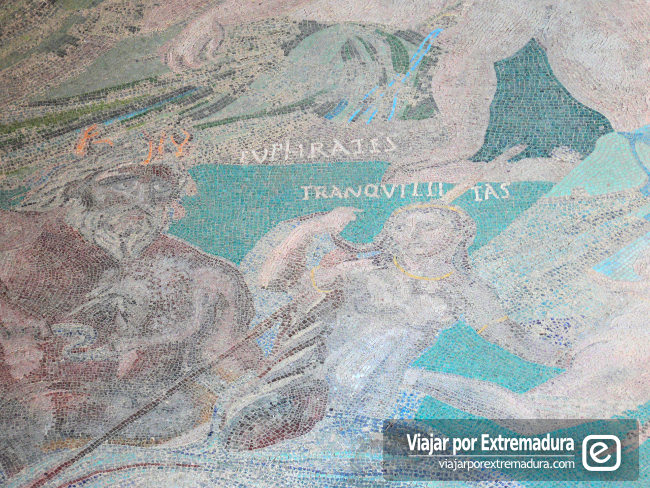
Cosmological Mosaic of the House of Mitreo
We can see some mosaics, among which the Cosmological Mosaic stands out, representing a scene with the forces of nature.
Funerary area of the Columbariums
It is located in the same complex as the House of Mitreo (visited together).
In this area were the funerary buildings (Columbariums) of at least two important families in the city.
Currently, numerous elements related to funeral rites from different periods are included.
Forums of Augusta Emerita
We return to the center of Mérida to visit various architectural elements that were part of the city’s forums: the Municipal Roman Forum and the Provincial Forum.
In our walk from the House of Mitreo complex, we can imagine entering Augusta Emerita through the southern gate and walking along the cardo maximus (the main street in a north-south direction).
Temple of Diana
This temple is one of the best-preserved, as it was used as the framework for a much later building (Palace of the Count of the Corbos).
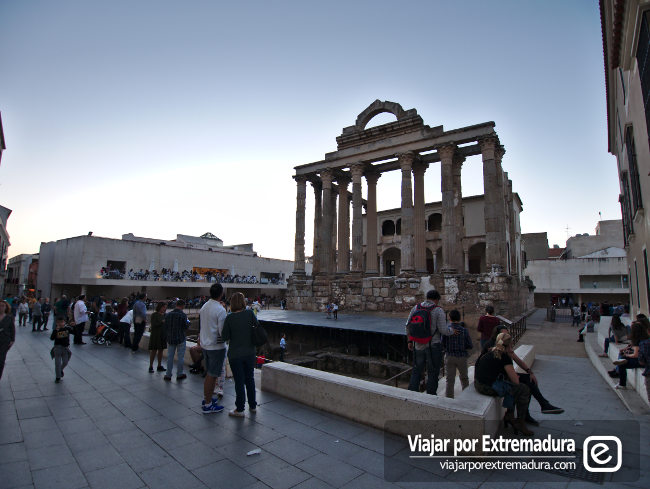
Temple of Diana in Mérida
It was a building dedicated to the worship of Rome and the Emperor and was inside the Municipal Forum.
The Municipal Forum was a public area where various religious, administrative, and legal buildings were located.
It constituted the heart of the Roman city, and from it, the main streets started: the cardo maximus and the decumanus.
The square where the Temple of Diana is located has been redesigned to highlight the Roman building and is beautiful. There is a small grandstand, and some performances take place in front of the temple.
You will find it going up Romero Leal Street.
Portico (of the Forum)
If we continue up Sagasta Street, we reach the Portico of the Forum.
This porticoed building was part of the Municipal Forum and was a space with gardens, decorated with numerous statues.
Trajan’s Arch
From the Temple of Diana square, we can follow any of the streets parallel to what was the cardo maximus, northwest, crossing Santa Eulalia Street (one of the best-known streets in Mérida) until we reach Valverde Lillo Street.
We go down to Trajano Street, and we will see Trajan’s Arch, which was actually a monumental gate, located on the cardo maximus, providing access to the Provincial Forum.
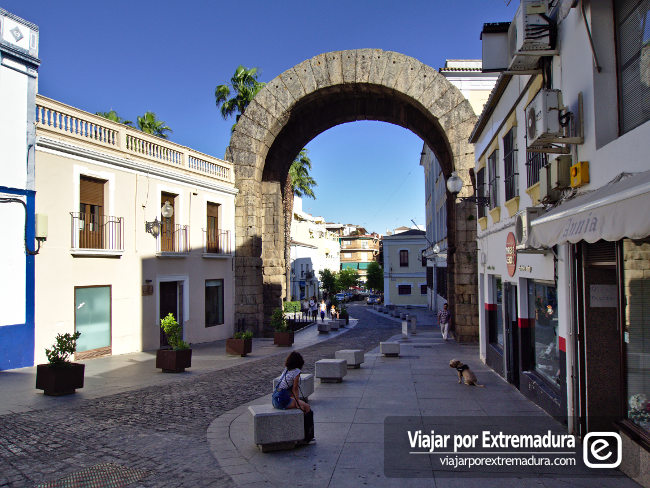
Trajan’s Arch in Mérida
It is not clear whether this area was a forum as such, with administrative buildings, or if it was a monumental square dedicated to imperial worship. In any case, it was a quite large area, built in the mid-1st century A.D.
When we pass through Trajan’s Arch northwest, we can imagine that we are entering the Provincial Forum.
Mérida’s Main Square
We go back on our steps on Trajano Street and go down Valverde Lillo street to Spain Square.
We find the Town Hall of Mérida and the Co-Cathedral of Mérida (Metropolitan Co-Cathedral of Santa María la Mayor).
Arab Alcazaba, Morerías, Roman Bridge
Taking Spain Square as a reference, we just have to go down Puente Street towards the Guadiana River.
Arab Alcazaba of Mérida
It was a defensive enclosure, both for protecting the city from external attacks and for protection against revolts against Muslim occupation.
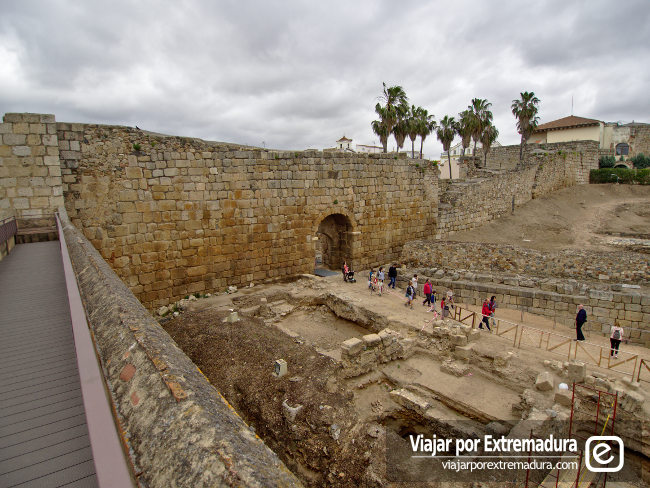
The Alcazaba was built by order of Abderramán II (Abd al-Rahman II) and was inaugurated in the year 835.
The visit is worth it because we can climb the walls to have spectacular views of the enclosure and the area of the Guadiana, including the Roman Bridge.
We can also visit, for example, the interior of the cistern located in the Alcazaba.
Roman Bridge over the Guadiana River
Considered the longest bridge of antiquity, it had a length of 755m and 62 arches.
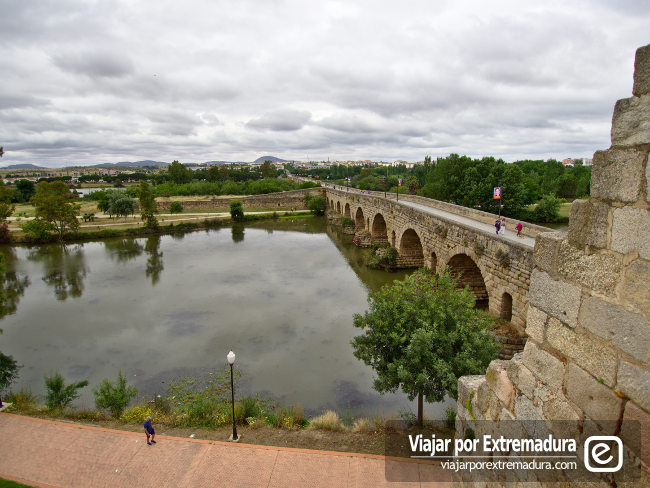
It was built at the end of the 1st century B.C. and has been in use for people and vehicles until the end of the 20th century, giving an idea of its robustness.
From the bridge, you can access the Parque de la Isla, one of the green areas of Mérida, ideal for walking or going with children.
Archaeological Area of Morerías
It is located a few meters from the Alcazaba, following the Paseo de Roma.
It is an area of special archaeological interest because it has been occupied throughout history by the different cultures that lived in the city of Mérida: Romans, Visigoths, Muslims, and Christians.
A stretch of the Vía de la Plata is preserved.
Next to the Morerías site is the Interpretation Center of the Vía de la Plata.
Roman Circus and Aqueducts
These buildings were located outside the walls of Augusta Emerita, to the north of the city.
We can visit them by car (Circus Roman area and Aqueduct of Miracles area) or we can take a walk along the course of the Albarregas River (which is landscaped, so it is a very pleasant walk, and the distance we cover is about 2km).
Roman Circus
The circuses were the most important leisure buildings in the Roman Empire.
In the circuses, chariot races were held, which, along with the spectacles of the Amphitheater, were the Romans’ favorite events.
Only large Roman cities had a circus.
The Roman Circus of Mérida had a capacity for about 30,000 spectators. Currently, part of the stands and the central spine are preserved.
San Lázaro Aqueduct
A few meters from the entrance to the Circus, we can see some of the original columns of the Roman Aqueduct of San Lázaro (also known as Rabo de Buey).
In this area, we also find the remains of some Roman Baths.
The aqueduct was renovated in the 16th century, reusing part of the materials from the Roman aqueduct.
If we follow the current aqueduct layout, we can see, in sections, the remains of the ancient Roman channel.
Aqueduct of Miracles
We continue along the course of the Albarregas River through the gardens on its right bank, towards the Aqueduct of Miracles.
It’s about a 15-minute walk.
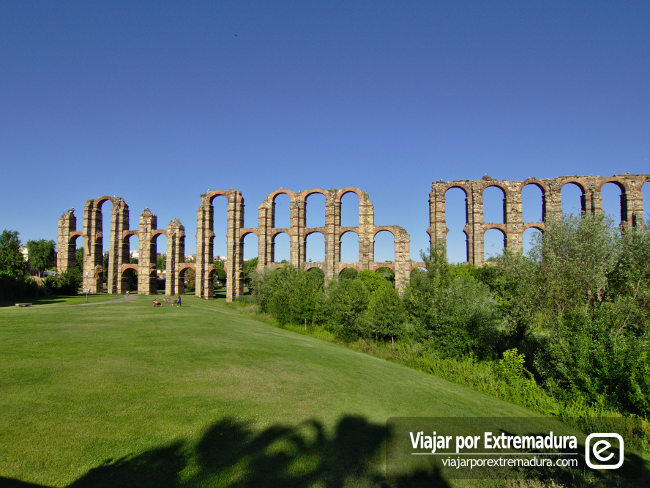
The Aqueduct of Miracles is an impressive engineering work. The visible part on the surface was over 800m long and about 25m in maximum height, to overcome the slope and carry water to the upper part of Augusta Emerita.
The rest of the channel was at ground level or buried and brought water from springs in the area of the Proserpina reservoir.
The central section over the Albarregas River is preserved, as well as some pillars from the part that went up to the Castellum Aquae (water tower), which served to supply that area of the city.
Roman Bridge over the Albarregas River
This bridge was part of the Vía de la Plata that connected Augusta Emerita with Asturica Augusta (Astorga).
It is located a few meters from the Aqueduct of Miracles.
Visigothic Mérida
This itinerary is thematic, focusing on the legacy of the Visigothic kingdoms in the city.
We will visit the Museum of Visigothic Art and Culture and the Basilica of Santa Eulalia.
Convent of Santa Clara
This former convent displays part of the Visigothic Art Collection of Mérida.
The Convent of Santa Clara is located a few meters from Spain Square.
The visit is free, and inside, we can see numerous pieces of sculpture, especially decorative elements from religious buildings.
Basilica of Santa Eulalia
The Basilica of Santa Eulalia is like a book that shows us different phases of Mérida’s history.
After the foundation of Augusta Emerita, this area was initially occupied by houses.
From the 4th century, it is used as a Christian necropolis, and probably one of the first Christian temples in Hispania existed here.
In the 5th century, a small basilica dedicated to the martyr Eulalia was built.
With the Muslim occupation, the building was abandoned. After the Reconquista, reconstruction took place in the 13th century, resulting in the building we see today.
However, the crypt is preserved, containing remains of the original basilica, and can be visited.
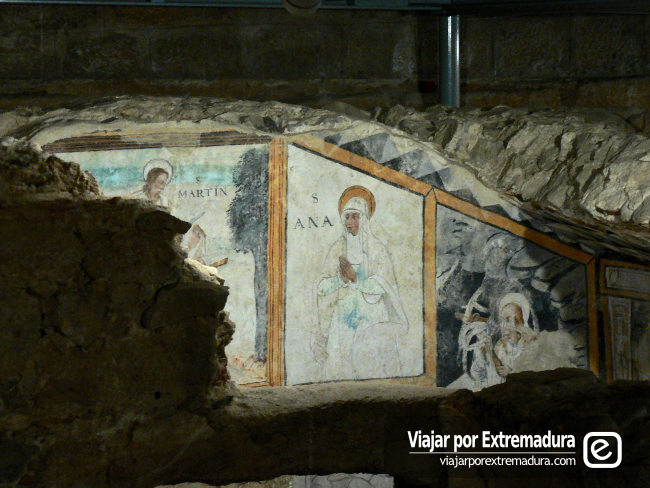
The Interpretation Center of the Basilica of Santa Eulalia also offers a lot of information about the historical evolution, and we can see objects found in the excavations.
Hornito de Santa Eulalia
In front of the Basilica of Santa Eulalia is this small Gothic-style chapel, which reuses some architectural elements that belonged to a Roman temple dedicated to Mars.
Around Mérida
Mérida is an excellent option as a base to explore all of Extremadura.
But if you have little time, you can try to visit some of these places located a few kilometers from the city.
A few kilometers from Mérida, it is a typical dehesa environment where the Roman dam of Cornalvo is located. It is a perfect place for hiking, enjoying nature, and bird watching.
More information about Cornalvo Natural Park
Proserpina Dam
About 3km from Mérida. It is a reservoir of Roman origin that has been remodeled in different later periods.
A very beautiful place to walk, and in summer, it is a popular bathing area.
Lácara’s Dolmen
Located on the road that connects Aljucén with La Nava de Santiago, about 20km from Mérida.
The Lácara Dolmen is one of the most important of its kind on west Europe.
Hotels and apartments in Mérida
You can find best hotels and apartments here
